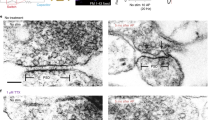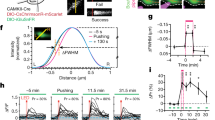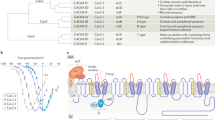Abstract
Presynaptic nerve terminals often contain as few as a hundred vesicles1,2 and so must recycle them soon after exocytosis to preserve synaptic transmission and presynaptic morphology3,4 during repetitive firing. The kinetics3,4 and mechanisms5 of vesicular endocytosis and repriming have therefore been studied. Vesicles in hippocampal nerve terminals can become available to release their contents within ∼40 s of the previous round of exocytosis6,7. Studies using the styryl dye FM1-43 (ref. 3) have estimated the time constant for endocytosis as ∼20–30 s (refs 4, 8), at least half of the total recycling time, which is much slower than endocytosis in other secretory systems9,10,11. It seems paradoxical that the neurosecretory terminals that could benefit themost from rapid endocytosis do not use such a mechanism. Here we demonstrate the existence of fast endocytosis in hippocampal nerve terminals and derive its kinetics from fluorescence measurements using dyes with varying rates of membrane departitioning. The rapid mode of vesicular retrieval was much faster after exposure to staurosporine or elevated extracellular calcium. Thus hippocampal synapses take advantage of efficient mechanisms for endocytosis, and their vesicular retrieval is subject to modulatory control.
This is a preview of subscription content, access via your institution
Access options
Subscribe to this journal
Receive 51 print issues and online access
$199.00 per year
only $3.90 per issue
Buy this article
- Purchase on Springer Link
- Instant access to full article PDF
Prices may be subject to local taxes which are calculated during checkout





Similar content being viewed by others
References
Harris, K. M. & Sultan, P. Variation in the number, location and size of synaptic vesicles provides an anatomical basis for the nonuniform probability of release at hippocampal CA1 synapses. Neuropharmacology 34, 1387–1395 (1995).
Schikorski, T. & Stevens, C. F. Quantitative ultrastructural analysis of hippocampal excitatory synapses. J. Neurosci. 17, 5858–5867 (1997).
Betz, W. J., Mao, F. & Smith, C. B. Imaging exocytosis and endocytosis. Curr. Opin. Neurobiol. 6, 365–371 (1996).
Ryan, T. A., Smith, S. J. & Reuter, H. The timing of synaptic vesicle endocytosis. Proc. Natl Acad. Sci. USA 93, 5567–5571 (1996).
Cremona, O. & De Camilli, P. Synaptic vesicle endocytosis. Curr. Opin. Neurobiol. 7, 323–330 (1997).
Ryan, T. A. et al. The kinetics of synaptic vesicle recycling measured at single presynaptic boutons. Neuron 11, 713–724 (1993).
Liu, G. & Tsien, R. W. Properties of synaptic transmission at single hippocampal synaptic boutons. Nature 268, 1624–1628 (1995).
Wu, L. G. & Betz, W. J. Nerve activity but not intracellular calcium determines the time course of endocytosis at the frog neuromuscular junction. Neuron 17, 769–779 (1996).
Thomas, P., Lee, A. K., Wong, J. G. & Almers, W. Atriggered mechanism retrieves membrane in seconds after Ca2+-stimulated exocytosis in single pituitary cells. J. Cell Biol. 124, 667–675 (1994).
Smith, C. & Neher, E. Multiple forms of endocytosis in bovine adrenal chromaffin cells. J. Cell Biol. 139, 885–894 (1997).
Engisch, K. L. & Nowycky, M. Compensatory and excess retrieval: two types of endocytosis following single step depolarizations in bovine adrenal chromaffin cells. J. Physiol. (Lond.) 506, 591–608 (1998).
Henkel, A. W. & Almers, W. Fast steps in exocytosis and endocytosis studied by capacitance measurements in endocrine cells. Curr. Opin. Neurobiol. 6, 350–357 (1996).
Heuser, J. E. & Reese, T. S. Evidence for recycling of synaptic vesicle membrane during transmitter release at the frog neuromuscular junction. J. Cell Biol. 57, 315–344 (1973).
Miller, T. M. & Heuser, J. E. Endocytosis of synaptic vesicle membrane at the frog neuromuscular junction. J. Cell Biol. 98, 685–698 (1984).
Koenig, J. H. & Ikeda, K. Synaptic vesicles have two distinct recycling pathways. J. Cell Biol. 135, 797–808 (1996).
Ceccarelli, B. & Hurlbut, W. P. Ca2+-dependent recycling of synaptic vesicles at the frog neuromuscular junction. J. Cell Biol. 87, 297–303 (1980).
Fesce, R., Grohovaz, F., Valtorta, F. & Meldolesi, J. Neurotransmitter release: fusion or “kiss and run”? Trends Cell Biol. 4, 1–4 (1994).
Henkel, A. W. & Betz, W. J. Staurosporine blocks evoked release of FM1-43 but not acetylcholine from frog motor nerve terminals. J. Neurosci. 15, 8246–8258 (1995).
Murthy, V. N. & Stevens, C. F. Synaptic vesicles retain their identity through the endocytotic cycle. Nature 392, 497–501 (1998).
Takei, K., Mundigl, O., Daniell, L. & De Camilli, P. The synaptic vesicle cycle: a single vesicle budding step involving clathrin and dynamin. J. Cell Biol. 133, 1237–1250 (1996).
Malgaroli, A. & Tsien, R. W. Glutamate-induced long-term potentiation of the frequency of miniature synaptic currents in cultured hippocampal neurons. Nature 357, 134–139 (1992).
Lagnado, L., Gomis, A. & Job, C. Continuous vesicle cycling in the synaptic terminal of retinal bipolar cells. Neuron 17, 957–967 (1996).
Kraszewski, K., Daniell, L., Mundigl, O. & De Camilli, P. Mobility of synaptic vesicles in nerve endings monitored by recovery from photobleaching of synaptic vesicle-associated fluorescence. J. Neurosci. 16, 5905–5913 (1996).
Parsons, T. D., Lenzi, D., Almers, W. & Roberts, W. M. Calcium-triggered exocytosis and endocytosis in an isolated presynaptic cell: capacitance measurements in saccular hair cells. Neuron 13, 875–883 (1994).
Burgoyne, R. D. Fast exocytosis and endocytosis triggered by depolarisation in single adrenal chromaffin cells before rapid Ca2+ current run-down. Pflugers Arch. 430, 213–219 (1995).
Plattner, H., Braun, C. & Hentschel, J. Facilitation of membrane fusion during exocytosis and exocytosis-coupled endocytosis and acceleration of “ghost” detachment in Paramecium by extracellular calcium. A quenched-flow/freeze-fracture analysis. J. Membr. Biol. 158, 197–208 (1997).
von Gersdorff, H. & Matthews, G. Inhibition of endocytosis by elevated internal calcium in a synaptic terminal. Nature 370, 652–666 (1994).
Ramaswami, M., Krishnan, K. S. & Kelly, R. B. Intermediates in synaptic vesicle recycling revealed by optical imaging of Drosophila neuromuscular junctions. Neuron 13, 363–375 (1994).
Zimmerberg, J., Blumenthal, R., Sarkar, D. P., Curran, M. & Morris, S. J. Restricted movement of lipid and aqueous dyes through pores formed by influenza hemagglutinin during cell fusion. J. Cell Biol. 127, 1885–1894 (1994).
Betz, W. J. & Bewick, G. S. Optical monitoring of transmitter release and synaptic vesicle recycling at the frog neuromuscular junction. J. Physiol. (Lond.) 460, 287–309 (1993).
Acknowledgements
We thank S. J Smith and T. L. Schwarz for critically reading the manuscript, members of the Tsien laboratory for comments; and J. Bergsman for discussions and suggestions. This work was supported by grants from NIMH, the Mathers Charitable Foundation, the McKnight Endowment Fund for Neuroscience (R.W.T.), and fellowships from the Boehringer Ingelheim Fonds (J.K.) and the American Heart Association California Affiliate (E.T.K.)
Author information
Authors and Affiliations
Corresponding author
Rights and permissions
About this article
Cite this article
Klingauf, J., Kavalali, E. & Tsien, R. Kinetics and regulation of fast endocytosis at hippocampal synapses. Nature 394, 581–585 (1998). https://doi.org/10.1038/29079
Received:
Accepted:
Issue Date:
DOI: https://doi.org/10.1038/29079
This article is cited by
-
BDNF impact on synaptic dynamics: extra or intracellular long-term release differently regulates cultured hippocampal synapses
Molecular Brain (2020)
-
Biphasic exocytosis of herpesvirus from hippocampal neurons and mechanistic implication to membrane fusion
Cell Discovery (2020)
-
Various approaches for measurement of synaptic vesicle endocytosis at the central nerve terminal
Archives of Pharmacal Research (2019)
-
Paraquat as an Environmental Risk Factor in Parkinson’s Disease Accelerates Age-Related Degeneration Via Rapid Influx of Extracellular Zn2+ into Nigral Dopaminergic Neurons
Molecular Neurobiology (2019)
-
Bidirectional regulation of Ca2+ in exo–endocytosis coupling
Science China Life Sciences (2018)
Comments
By submitting a comment you agree to abide by our Terms and Community Guidelines. If you find something abusive or that does not comply with our terms or guidelines please flag it as inappropriate.



